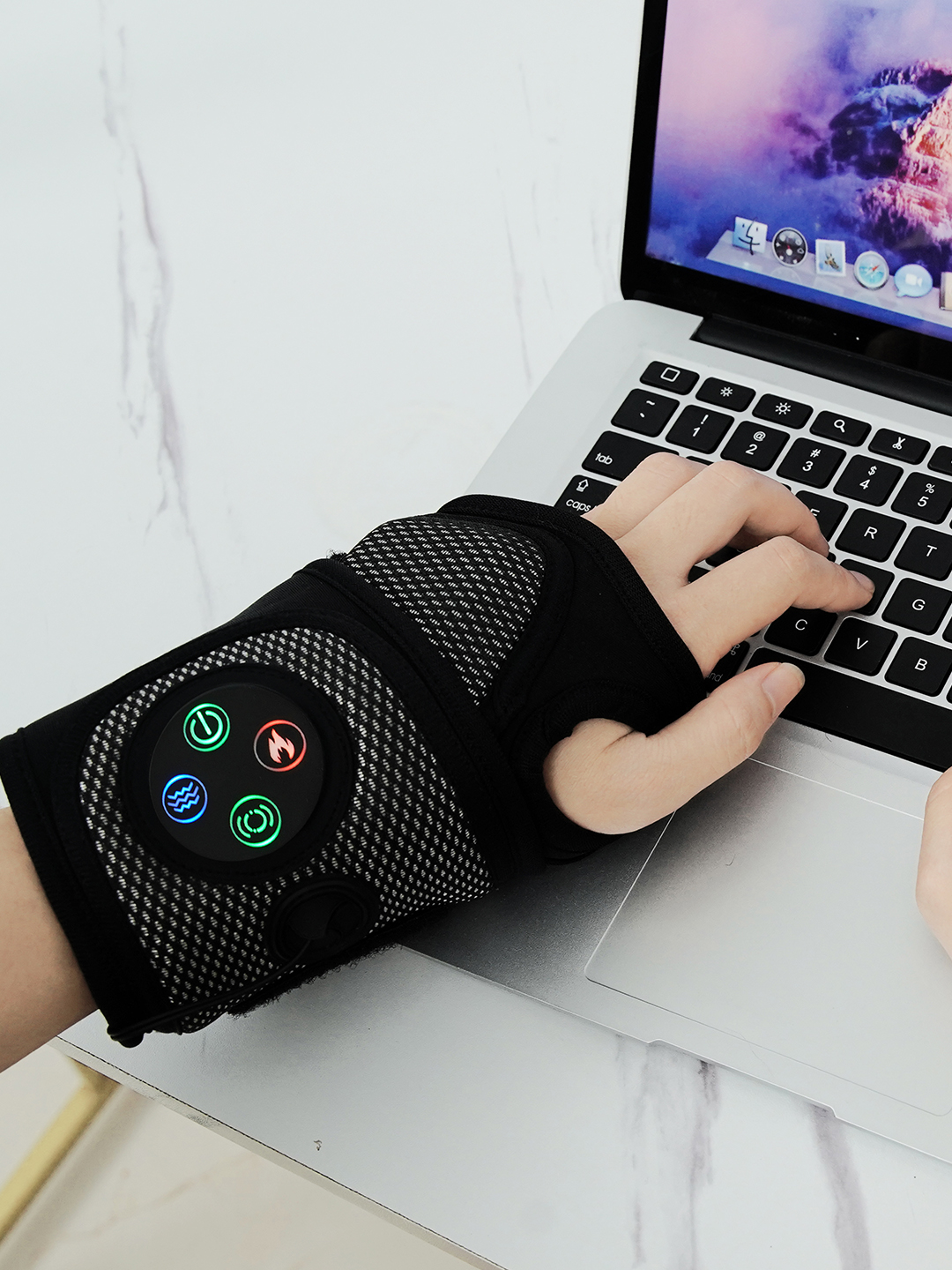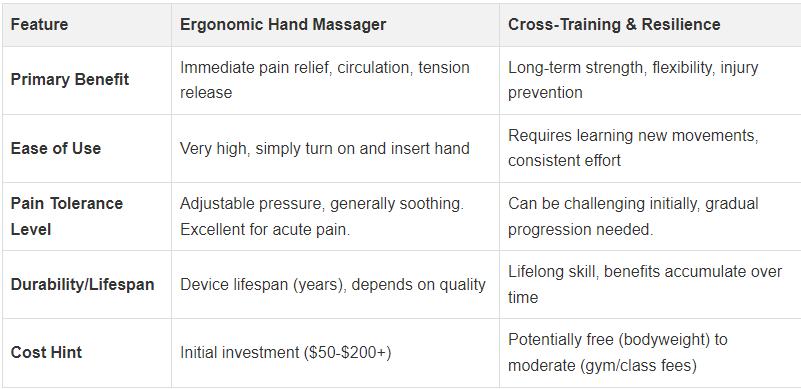Hand Massager for Career Fatigue: Solutions & Relief
- By Grace
- Updated on
Imagine this: you're a massage therapist, your hands are your livelihood, yet they ache constantly. Or perhaps you're simply someone who spends hours typing, knitting, or gardening, and the persistent pain in your hands and forearms is becoming an unwanted constant companion. Have you ever felt that nagging discomfort, that stiffening grip, preventing you from enjoying your daily life or even performing your job effectively? You're certainly not alone. Many professionals, and indeed anyone experiencing repetitive strain, grapple with this challenge. But here's the good news: there's a world of solutions out there, from advanced hand massager devices to empowering self-care strategies, all designed to bring you much-needed relief and enhance your hand health.
Stop Hand Aches with Ergonomic Hand Massagers
When it comes to alleviating immediate tension and improving circulation, the right tools can make all the difference. Modern hand massagers are designed not just for relaxation, but for targeted therapeutic relief. They often employ a combination of air compression, heat therapy, and rolling nodes to gently knead away stiffness and pain. The principle is simple yet effective: increased blood flow helps deliver nutrients and oxygen to tired muscles, while compression and targeted pressure release accumulated tension in the joints and soft tissues of the hand and forearm.
This approach is a godsend for professionals like massage therapists, who put immense strain on their hands daily, or anyone suffering from the fatigue of repetitive motions. Forget about cumbersome, large medical equipment; today's ergonomic hand massagers, like the Klcosy series, are compact, powerful, and multifunction. They fit neatly on your desk or bedside table, offering instant access to relief whenever you need it. By prioritizing these specifically designed devices, you can maintain consistent care without disrupting your busy schedule. Think of it as a mini spa treatment for your hands, available 24/7!
- Air Compression: Gently squeezes the hand, promoting circulation and reducing swelling.
- Heat Therapy: Warms tissues, enhancing blood flow and soothing stiff joints.
- Rolling/Kneading Nodes: Mimic human massage techniques to target pressure points and muscle knots.
- Vibration: Can help stimulate nerve endings and improve overall sensation.
- Ergonomic Design: Shapes that fit the natural contours of your hand for maximum contact and comfort.

Is Massage Good for Hand Arthritis?
While immediate relief is crucial, true hand health often requires a more holistic, long-term strategy. This is where physical resilience through cross-training comes into play. It's not just about treating pain after it strikes; it's about building a stronger, more flexible foundation for your hands and forearms to prevent future issues. The mechanism here involves strengthening the supporting muscles around the joints, improving range of motion, and enhancing overall joint stability. These strategies complement the work done by a hand massager by addressing underlying weaknesses.
For those asking, "Is massage good for hand arthritis?" the answer is often a resounding yes, when combined with strengthening and mobility exercises. Gentle massage can reduce stiffness and pain associated with arthritis, but cross-training helps maintain mobility and function. Yoga, for example, offers gentle stretches and weight-bearing poses that can improve wrist and finger flexibility and strength. Strength training, even with light weights or resistance bands, can build up forearm and grip strength, providing better support for your hands. It’s like building a strong, sturdy house instead of just patching up cracks.
- Yoga & Pilates: Improve flexibility, balance, and core strength, indirectly supporting arm and hand mechanics.
- Light Strength Training: Focus on forearm curls, wrist extensions, and grip exercises to build supporting musculature.
- Resistance Band Work: Excellent for controlled, low-impact strengthening of hand and finger muscles.
- Proprioception Exercises: Activities that improve awareness of hand position and movement, reducing injury risk.

Choosing Your Hand Savior: massagers vs. Resilience Training
Deciding between a quick fix and a long-term strategy can be tricky, right? Actually, the best approach often involves a combination of both! A hand massager provides immediate, on-demand relief, which is invaluable for managing daily discomfort and recovery. It’s perfect for those acute moments of pain or for winding down after a long day of work. However, for chronic conditions like arthritis or to genuinely prevent future injuries, integrating resilience training is paramount. Here's a comparative look to help you tailor your personal hand care plan:

When to DIY & When to Seek the Pros: Your Hand Health Compass
Knowing when to rely on your trusty **hand Massager** and when to pick up the phone for a medical appointment is a crucial part of smart self-care. Do you ever wonder if you're doing enough, or if it's time for professional intervention? Generally, if your pain is mild, sporadic, and responds well to self-massage and rest, then at-home care is a fantastic first line of defense. The Klcosy massager, or other similar self massage tools, are truly designed for this everyday maintenance.
However, there are clear signs that indicate it’s time to consult a healthcare professional. Persistent numbness, tingling, or weakness that doesn't improve with self-care could be a red flag for conditions like carpal tunnel syndrome that may require a doctor’s assessment. Likewise, if your pain is severe, accompanied by swelling, redness, or deformity, or significantly impacts your ability to perform daily tasks, don't delay. A doctor or physical therapist can provide an accurate diagnosis, recommend specific treatments, or guide you on the best path for conditions like arthritis or nerve impingement. Remember, proactive health management is the cornerstone of a pain-free life.
- Self-Assessment: Does the pain subside with rest and self-massage? Is it localized or spreading?
- Symptom Monitoring: Keep a pain journal. Note frequency, intensity, and what helps or worsens it.
- When to Call: If symptoms worsen, persist for more than a few weeks, or include numbness, severe weakness, or loss of function.
- Professional Guidance: A physical therapist can provide tailored exercises and manual therapy, while a doctor can rule out more serious conditions.
Hand Health FAQs:
Do hand massagers help carpal tunnel?
Actually, many people with carpal tunnel syndrome find considerable relief from using hand massagers. While a massager won't "cure" carpal tunnel, which is often caused by compression of the median nerve in the wrist, the gentle compression, heat, and kneading can significantly reduce swelling, improve circulation, and relax the muscles in the hand and forearm. This can alleviate some of the pressure on the nerve, leading to reduced pain, numbness, and tingling. It’s an excellent complementary therapy, but always consult a doctor for diagnosis and comprehensive treatment.
Is massage good for hand arthritis?
Yes, absolutely! For most types of hand arthritis, gentle massage can be incredibly beneficial. It helps to increase blood flow to the affected joints, which can reduce stiffness and pain. It also helps improve the range of motion in the fingers and wrists by stretching the surrounding tissues. However, it's crucial to use a gentle touch, especially during flare-ups, and avoid any massage that causes increased pain. A good hand pain massager designed with heat and gentle compression can be ideal for this, offering soothing warmth and light pressure.
How to massage hands with arthritis?
When dealing with arthritis, the key is gentle, consistent care. Here’s a basic approach, whether using a **hand massager** or your own hands:
- Warm-Up: Start by soaking your hands in warm water or applying a warm compress for 5-10 minutes. This increases blood flow and relaxes the tissues.
- Gentle Kneading: If using a massager, select a low-pressure setting. If using your own hands, use your thumb to gently knead the palm of your hand, focusing on the fleshy areas.
- Finger Circles: Gently rotate each finger at its base. Then, gently pull each finger outwards to create a light stretch, being careful not to hyperextend.
- Joint Support: Massage around the knuckles and finger joints, using small, circular motions. Avoid direct pressure on swollen or inflamed joints.
- Forearm Extension: Don't forget your forearms! Gentle strokes along the forearm can relieve tension that contributes to hand pain.
- Consistency: Perform this routine daily, or whenever you feel stiffness, for the best results.
In conclusion, saving your hands and forearms from the relentless march of daily strain is entirely within your grasp. Whether you're a busy professional needing targeted relief from a powerful hand massager or someone building long-term resilience with cross-training, the path to healthier, happier hands is paved with proactive choices. Take action today, explore the options, and give your hands the care they truly deserve. After all, they work hard for you every single day!




